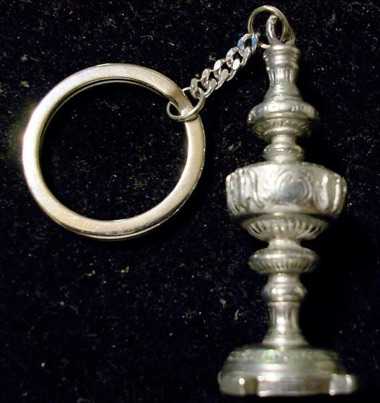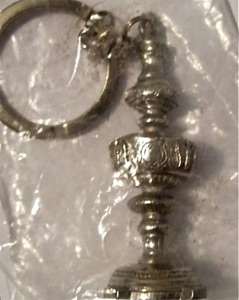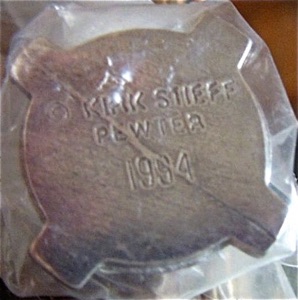The Preakness
The Woodlawn Vase


The Preakness
The Woodlawn Vase


In 1967, The Stieff Company bought Schofield. With that purchase came the annual re-creation of the Woodlawn Vase, the trophy given for the Preakness horse race at Pimlico in Baltimore. The actual trophy is held by the Maryland Historical Society and is valued at over 4 million dollars.
Shown below is the one-third size replica that was made in 1970, and won by “Personality”. While beautiful, the replicas do not exactly replicate the stunning 1860 work of Tiffany, creators of the Woodlawn Vase. At the bottom of the page is more information on this trophy.
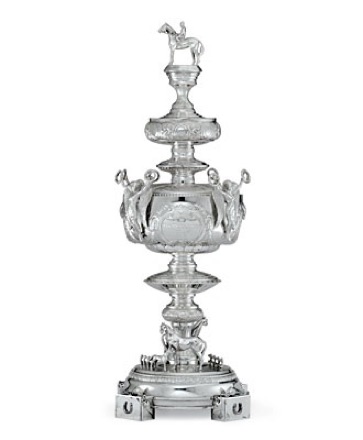
The Replica, 1970
12.25 inches tall
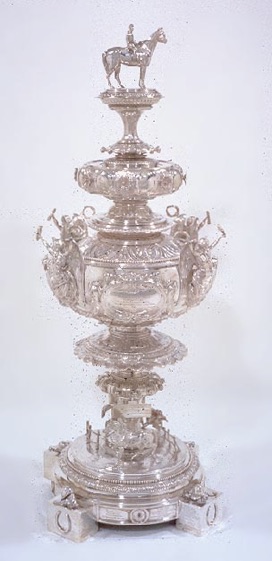
The Woodlawn Vase by Tiffany.
34 inches tall, 29 pounds, 12 ounces
Replica Description
Set on four tack-trunk formed feet with applied horseshoes, jockey caps, saddles, and crops, supporting a circular domed base with three standing horse figures with fences on a realistically modeled grass ground, with a baluster stem, the upper section with applied figures of Victory holding laurel leaves, with cartouches engraved The Preakness, Pimlico, 1970, Won by Personality, Owner Ethel D. Jacobs, the finial formed as a horse and jockey.
The original "Preakness Trophy", now kept in the Maryland Historical Society, was designed by James H. Whitehouse & Eugene J. Soligny at Tiffany & Co. It was originally commissioned in 1860 by R. Aitcheson Alexander for the Woodlawn Race Course near Louisville, KY. It passed through various hands until 1917 when it became known as the 'perpetual' trophy for the Preakness Stakes. The original trophy is illustrated in John Loring, Magnificent Tiffany Silver, pp. 76-77.
So, who makes the Woodlawn Vase replicas today???
Jim Stieff of course!
Excerpted from an article: May 19, 2011 |By Candus Thomson, The Baltimore Sun
The job of turning more than 12 pounds of silver into the foot-tall trophy belongs to Jim Stieff, 59, whose family began making silverware and decorative pieces at Liberty and West Fayette streets in 1892.
The Stieff name became known in both the sports world — the company made trophies for tennis, horse racing and yachting — and high society with its work at the White House and Colonial Williamsburg.
Despite the fact that the company was swallowed up more than once by larger corporations before finally being abandoned, Stieff never relinquished his grip on the molds used to make the Woodlawn replica. When he finally struck out on his own about six years ago, he took everything to Michael Izrael, a Russian immigrant with a doctorate in physics and chemistry and a love of silversmithing.
Izrael devised a new set of molds to take advantage of a proprietary casting process that creates a better replica.
"It's a lot of parts," says Izrael from his Queens, N.Y., shop. "Fourteen large parts and 36 little parts. It's like a Christmas tree and ornaments."
Soldering takes time and patience.
"When it's small it's always complicated. You need a magnifying glass to work or you make it ugly. Any small mistake on the nose or ear — agggh. It's not easy," says Izrael.
Over the years, Stieff and later Kirk Stieff was asked to make small souvenirs for the Preakness. Below are several examples.


With a pewter Smithsonian Collection Funnel as a starting point...
cast pewter jockeys were added to make this pieces special. They were made for the owners of the Preakness horses and the jockeys.
(cast jockeys were made by Richard Cain)
(from my personal collection)
1994 brought this miniature, less detailed version of the Woodlawn Vase in pewter and sold at the Pimlico Racetrack to the general public.
